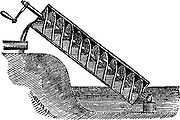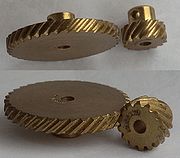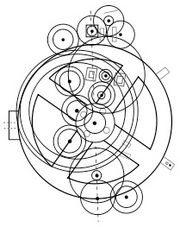Gadgeteering
From Mizahar Lore
| Line 10: | Line 10: | ||
==Prerequisites and Related Skills== | ==Prerequisites and Related Skills== | ||
| - | Gadgeteering is a complex discipline encompassing elements from other skills. The successful inventor will want at least basic competence in the following skills. | + | Gadgeteering is a complex discipline encompassing elements from other [[skills]]. The successful inventor will want at least basic competence in the following skills. |
* [[Drawing]] is required for sketches and blueprints. | * [[Drawing]] is required for sketches and blueprints. | ||
* [[Metalsmithing]] is required to produce gears and other metallic components. | * [[Metalsmithing]] is required to produce gears and other metallic components. | ||
Current revision as of 13:03, 21 May 2011
| Out of character note: As Gadgeteering has the potential to introduce an unwanted technological level to Mizahar, players may not introduce concepts such as steam power, guns and advanced explosives typical of the Industrial Revolution. Gadgeteers may use air and hot air in their inventions when it is not providing them with power (for example, a hot air balloon). It is also to be understood that mass production of Gadgeteering items is and will remain impossible. Please also note that characters without sufficient knowledge of science and machines are unable to suggest new or strange ideas. For example, a farmer or mercenary would most likely not know that it is even possible to create a lung simulation or glider. Characters wishing to suggest such things must do proper research and investigation. |
Gadgeteering is the skill of conceiving, designing, constructing and repairing machines. Products of Gadgeteering often seem to defy the rules of nature and can appear magical to the ignorant eye; in fact, the discipline is well grounded in physics and science, though interactions with magic are possible at the highest levels.
Contents |
History

Gadgeteering is said to have originated in a conglomerate of city-states called the Klipzian Pact, approximately 6500 BV. Populated by a sub-race of Humans with weak magical and martial talents, these cities nonetheless thrived by integrating machinery in everyone's daily life. Following the Pact's sudden destruction at the hands of Suvan, surviving Gadgeteers exported their knowledge to the rest of the world. Suvan refined such knowledge to build powerful war machines and siege weapons, whereas Alahea finally managed to produce fully humanoid golems with functional joints. A few magic schools in Alahea considered Gadgeteering as part of paramagic, that is, support disciplines useful for a wizard to know.
Prerequisites and Related Skills
Gadgeteering is a complex discipline encompassing elements from other skills. The successful inventor will want at least basic competence in the following skills.
- Drawing is required for sketches and blueprints.
- Metalsmithing is required to produce gears and other metallic components.
- Carpentry is required to shape and work with wood components.
If certain pieces exceed the Gadgeteer's ability to make, he can seek assistance from a specialist - for example, in crafting very advanced gears.
Machines
A machine is any device using energy to perform work of the desired type. Energy has to come from somewhere, and is often provided by muscle power (for example, through torque or wind-up mechanisms), wind, or hydraulic pressure. Only masters can use general-purpose magical devices (such as a Stormwarden's Stormgem or a Magecrafted item) and use them as power sources. If the magical technique is capable of recharging itself, then the device may appear to possess "perpetual motion" - indeed, Animation can turn a piece of Gadgeteering into a sentient, moving object. A machine will never generate more energy than it takes from the environment, however.
Simple machines
A simple machine is a machine that converts the direction or magnitude of a force. Novices begin by studying these and combining them in simple ways. Even novices can produce useful inventions out of these basic components, like the pumpscrew, a simple hydraulic pump that can lift water from low places (for example, to drain a flooded mine shaft). Six simple machines are recognized by mainstream Gadgeteers:
- Lever
- Wheel and axle
- Pulley
- Inclined plane
- Wedge
- Screw
Gears
The true power of Gadgeteering is harnessed through gears, rotating machines evolved from the screw with teeth or cogs meshing together to transform force in complex ways. Gears of different sizes and tooth counts meshing together can change the speed, magnitude, and direction of a power source. If this is their only purpose, the system is called a transmission. The traditional spur gear is the simplest model, with two spur gears only being able to transmit force along the same plane, but helical gears can be placed in different spatial planes, as seen in the figure. A gear needs not mesh with another gear; it can also be linked to a straight toothed part ("rack and pinion"). There are countless variations of gears and uses that can be made of them.
The most famous application of gears is the clock, from which the word 'clockwork' was coined. Mechanical clocks were wildly popular before the Valterrian, but now are a status symbol of the rich and powerful. In order to make a clock, the Gadgeteer needs to be familiar with escapement. Escapement transforms continuous motion into periodical or oscillatory motion, as in the ticking of a clock. Escapement is the source of all timing devices in clockwork.
Automata
An automaton is a machine that displays automatic behavior once started. They are a cheaper (and probably safer), non-magical alternative to Animation and can be used in tandem with it. Automata were first created as toys, and were capable of moving and performing certain tasks such as playing drums or playing simple games. Very skilled Gadgeteers can make these automata programmable through simple switches, levers and panels. Automata often work through wind-up devices based on a mainspring, but some automata have been powered by wind energy. The master's ability to interface with magic power sources led to the birth of the occasional "horseless chariot" in ancient Alahea, usually considered an extravagance of the incredibly rich.
Skill Progression
At every level, the Gadgeteer can repair machines of that level and lower. It will take them longer to do so if the machine was built by another Gadgeteer.
| Novice (1-25) | |
| Novices have a basic theoretical foundation and can use the six simple machines, combining their effects and principles to achieve greater goals. They can design an invention from scratch, though at this level it will take them some trial and error. Their machines will rarely sell for more than a few dozen Mizas, frequently less than 20. | |
| Competent (26-50) | |
| At this level the Gadgeteer knows how most common gears work. The knowledge is sufficient to build clocks and simple toy-sized automata. He will also have a decent understanding of hydraulic pressure, to the point where he can begin incorporating it in his inventions. An accurate quality clock can easily command 100 Mizas on the market, though it involves considerable work on the Gadgeteer's part. If accuracy is not a requirement, clockwork becomes easier to make and cheaper to buy. | |
| Expert (51-75) | |
| An expert has extensive knowledge of Gadgeteering and can produce complex clockwork, the likes of which are seen in astronomic clocks, mechanical abaci and other programmable devices. Machines can be man-sized or larger, including mighty war machines and siege weapons, or increasingly small and miniaturized. The Gadgeteer knows pneumatics - the art of making air flow through an invention, for example to create mechanical organs that might simulate certain effects - as well as aerodynamics, allowing them to create gliders, hot air balloons and other machines that work with the air. A fine piece of Gadgeteering at this level can sell for several hundred Mizas up to a few thousands, depending on complexity. | |
| Master (76-100) | |
| A master-level Gadgeteer is rarely seen in today's Mizahar. They can design build almost anything, at any level and size. They are the only ones who can build humanoid clockwork automata with fully functional limbs and joints. These automata can also be turned into splendid golems by Animators. They can use magical power sources, transforming them into linear and angular force through complex clockwork. This makes machines much more compact and opens up almost unlimited avenues of research. Their inventions of the highest caliber sell in the thousands or tens of thousands of Mizas, meaning that few private individuals will be able to afford them. | |





